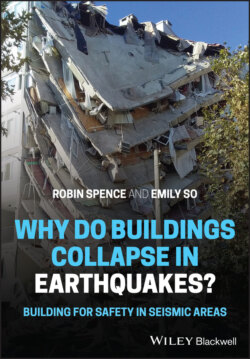Читать книгу Why do buildings collapse in earthquakes? Building for safety in seismic areas - Robin Spence - Страница 23
2.2.7 The 12.1.2010 Haiti Earthquake: Mw7.0, Estimated More Than 222 000 Deaths
ОглавлениеThe Mw7.0 earthquake which struck the Republic of Haiti at 16.53 local time on 12 January 2010 was one of the most destructive in history. It had its epicentre 25 km from the capital city of Port‐au‐Prince, at a depth of 13 km, and very strong to severe ground shaking was felt throughout the city, which had a population of 3 million, and the surrounding region, resulting in collapse or critical damage to more than 300 000 homes. In addition, the Government of Haiti estimated that 60% of the nation's administrative and economic infrastructure was lost, and 80% of the schools and 50% of the hospitals were destroyed or damaged. The death toll was initially given by the Haiti Government as 316 000 (DesRoches et al. 2011) but an estimate of around 220 000 is now widely accepted, although other estimates range from 46 000 to 159 000. This would still mean that death toll as a proportion of the nation's population was greater than in any earthquake in modern times (DesRoches et al. 2011).
Although detailed post‐mortem data are not available, all reports point to poor standards of building construction leading to building collapse as being the principal cause of the immense death toll (DesRoches et al. 2011; EEFIT 2010; Marshall et al. 2011). The majority of houses were of one or two storeys, made of a mixture of concrete block masonry and RC frame construction. In some cases, the frame was built after the masonry walls, as in confined masonry construction; in other cases, the walls were infill within a previously built frame, and some investigators found that the ‘wall‐first’ buildings performed better in the earthquake. But for both types of construction, the materials used, the amount and detailing of the reinforcement and the process of construction were generally inadequate, resulting in buildings which were totally unable to resist the earthquake forces they were subjected to. Failures of the concrete frame leading to the overturning of masonry walls were common (Figure 2.13). Engineered commercial buildings mostly performed better, and most of the few traditional timber‐framed buildings remaining in the city suffered only moderate damage (EEFIT 2010).
Figure 2.13 Typical damage to low‐rise informal building in Port au‐Prince.
Source: EEFIT. Reproduced with permission.
The vulnerability of Haiti's building stock had a number of underlying reasons. There had been no significant earthquakes in the area since the eighteenth century, so earthquake awareness was low. Haiti is the poorest country in the Western hemisphere, and lacks effective government institutions, so there was no effective building code. Topography and ground conditions probably contributed to the scale of the damage, with some soils causing ground motion amplification, and failure of buildings on steep slopes resulting from foundation failure (EEFIT 2010).
Because of the extent of damage and the chaotic post‐disaster situation, investigating and quantifying the extent of the damage presented a serious problem in this event, and it was the first in which a crowdsourcing approach was used to map the damage using high‐resolution satellite images (Ghosh et al. 2011). Over 600 individual damage analysts from 24 different countries participated in this work. A first map of building damage, identifying over 5000 collapsed buildings, was assembled within 48 hours of the project being commissioned, and a second map, using higher‐resolution aerial photographs, and delineating more than 30 000 heavily damaged or destroyed buildings, was completed within three weeks (Ghosh et al. 2011). These maps made an important contribution to the World Bank and EU's Post Disaster Needs Assessment, completed in the first few weeks after the event. Ground surveys were conducted by an EEFIT team to validate these maps (EEFIT 2010), and found that while the damage they identified was correct, the aerial maps missed a significant amount of serious damage, because it could not be seen in the vertical image.
